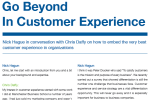
Download the PDF version
Nick Hague, Chairman of B2B International, in conversation with Chris Daffy, customer experience guru. Nick and Chris discuss how to embed the very best customer experience in organisations.
Nick Hague: Chris, let me start with an introduction from you and a bit about your background and expertise.
Chris Daffy: My interest in customer experience started with some work I did at Manchester Business School a number of years ago. I had just sold my marketing company and wasn’t sure what to do. I began lecturing on marketing strategy which was my background and experience. It quickly started moving across to the subject of differentiation. People came to the Business School saying that they were caught in the commodity trap and losing customers and money. That is a steep slippery slope where you end up being no different to your competitors. As Michael Porter says “When all things are equal, people buy on price.”
This led to a search for something that would make a worthwhile difference. Differentiation is fine but you have to find a way of differentiating that competitors can’t copy and that customers will value.
For many organisations the best way we could help them differentiate was to use service which customers valued. Services are more difficult to copy by competitors. Services produce feelings and it is hard to copy a feeling. If you give your customers a warm and positive feeling when they do business with you, it is hard for a competitor to copy that.
I spent two or three years at the Business School focusing on this subject, until I broke out on my own to form the Academy of Service Excellence.
Nick Hague: I think it was Peter Drucker who said “To satisfy customers is the mission and purpose of every business”. We recently carried out a survey that showed differentiation is still the number one challenge that businesses face. Customer experience and service strategy are a vital differentiation opportunity. This will never go away and it is especially important for business to business companies.
Chris Daffy: Yes. There has been much research done into this internationally. It shows that, if you get your formula right with a combination of the right level and style of service, it is a differentiator. It will cause customers to say “I would like to use this supplier regularly and they are my first choice.” They may also say “They would be my first choice of supplier, even if they are a bit more expensive than the competitor. There is definitely value in the way they look after me and my colleagues.” If you can get them to say or think this, it won’t matter if you are not the cheapest.
Nick Hague: I recall a business to business study that showed over 50% of people have recommended a brand because of a positive customer experience. These customers stayed loyal, paid more and became advocates. In that same survey only one in seven of these large B2B companies confessed they are truly customer-centric. Why do you think that B2B organisations struggle with customer service excellence?
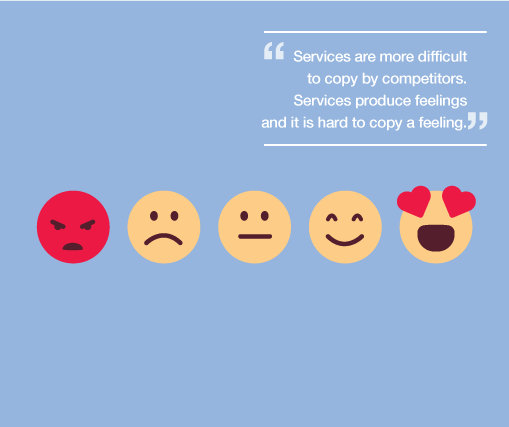
Chris Daffy: There are a number of reasons. First, you tend to focus on what you know and you tend to find that in B2B businesses they are really good with the process stuff. They have to be, whether it is a service or a product. They become experts in systems such as lean operations, Six Sigma, quality management or continuous improvement.
This is good but more is needed. The starting point is to convince the leadership of the need for customer excellence. Knowledge on how to deliver exceptional customer experiences has to be acquired and new skills have to be developed so that they can use the techniques of customer experience management just as they use the techniques of process management.
The next thing to address is the attitude business to business companies have to customer service. They can think of it as soft, namby pamby stuff. However, properly applied, customer experience deliver is hard stuff. At a high level, customer experience is seen as obviously good and it is easy to understand. But it is hard to apply effectively. When it is applied well it can have a massive influence on the bottom line. If a company is facing threats from competitors and haemorrhaging customers, it can reverse that trend if it’s properly applied.
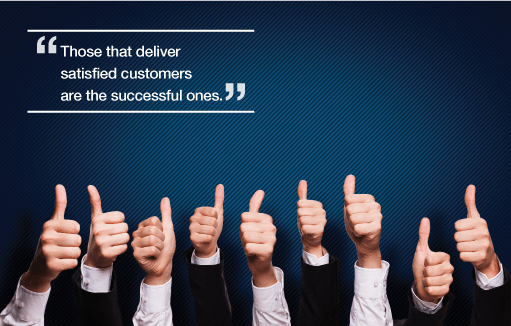
Nick Hague: Turning the soft stuff into hard stuff can be achieved by metrics and measurements, can’t it? When we are presenting to boards of companies we find that, if you relate the soft metrics of satisfaction or loyalty to revenue at risk, it makes more sense to them. This is when the Finance Director sits up and takes notice and puts some effort into doing something about it.
Chris Daffy: Historically those aren’t the metrics that have been tied together. Normally you would tie cost of production, cost of delivering the service, profit per product, profit per type of customer; very simple measures. The metrics you’re talking about are more difficult to find but they are far more useful when you’ve got them. They are there, and they just need looking for.
Nick Hague: Satisfying customers isn’t new is it? It is the number one objective for most businesses and those that deliver satisfied customers are the successful ones. Fred Reichheld in ‘The One Number You Need To Know’ introduced the Net Promoter Score (NPS) and since then thousands of companies have adopted his approach. What do you recognize in this trend?
Chris Daffy: Regarding NPS, you have to remember that what Reichheld was looking for was a measure of future loyalty. The question, “How likely would you be to recommend XYZ company” gives you a clue as to what’s likely to happen to loyalty in the future. It’s very good at that. It’s certainly made a massive impact and it is free; you can just ask it yourself.
The net promoter score is a good starting point and it is useful for monitoring a trend. It tells you how you are doing – but alone it is not enough. I would say that the focus nowadays, for those who are seriously interested, would be “How easy is it to do business with us?” They call it the effort score and I am sure you are doing measurements in that area as well.
Nick Hague: Yes – an important metric – aligned to the ease of doing business.
Chris Daffy: Next we should think about the experiences that customers remember most. We need to know how strong are the memories about things that happen when they do business with a company.
You can give people five, fifty, or a hundred experiences but there could be just the odd one or two that stick out and they remember. Memory, above all, drives future decision-making.
The other key element which often links to memory is how we make customers feel, and there is a lot of work taking place that shows there is a direct link between the way we make customers feel, the loyalty that will grow, and the sales and margins that we get as a result. One of the triggers for this was talked about by Colin Shaw in Beyond Philosophy. There is a definite connection between feelings and profitable customer experience. This is why people now are trying hard to measure feelings. “How do we make you feel?”, “What makes you feel valued?”, “What makes you feel that we care about you?”; those kind of things.
Nick Hague: We have seen that too. Emotions are becoming more and more part and parcel of how you can build great customer experiences and leave long lasting positive memories. We have talked about great experiences and you have just mentioned memories and emotions. Where do you think it is going?
Chris Daffy: There are three mind-states. One is looking forward – what might happen. This is the expectation: “I am thinking about the future. Should I be doing this or shouldn’t I be doing this?”
Then there is the experience state where I am in it, “I am actually doing it and I am experiencing what it is like”.
Then there is the third state where we look back and think “How was it?”.
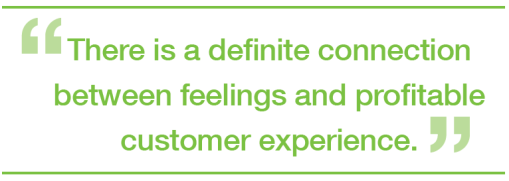
There is a lot of focus on the experience. This is not enough because the experience alone won’t do the job that could be done. As you know, I am very strongly advocating that first of all, we should make sure that it’s joined-up and that, expectations are matched or exceeded by experiences. People at the front-end, making promises, are supported by people in the middle or, later, that deliver those promises. If they can’t, it affects future loyalty. This disconnect happens a lot. We have to make sure that the experiences that are delivered are matched to those expectations that are being given, and then finally make sure that, within those experiences, we create good memories. The customer has to be able to think back about those memories and say “I really think that was great; I would like it again, so I will go back there.”
We need to think beyond customer experience management and think about customer loyalty management which is a combination of managing expectations, managing experiences, and managing memories as well.
Nick Hague: How do we go about implementing this?
Chris Daffy: The default is “Let’s train our front-line people to be nicer to our customers.” That is not where you start. You do not start from the front-line if it is not happening already. You start inside the organisation; it is an inside-out process, not a surface process.
The starting point is leadership and strategy. In other words, do the leaders fully understand the link between fantastic customer experience and the bottom line?
Next, we have to have the right people with a culture that supports service. If we have the right people in the wrong culture, they will leave.
We then need systems and processes which will enable people to deliver the kind of service we want. It is no good having really nice people on the front-line if, when they turn to use the it, the system that’s supposed to help them deliver service fails. So have you got the systems and processes in line that are properly aligned to make sure that we are serving customers well?
Then there is training because it is important that leaders, middle people and the front-line people all understand what they need to do and why.
Along with all that there is a lot of the invaluable stuff which you and your team do which is measuring what’s going on; knowing where we are and knowing how effective we are. My favourite measurement is something I call real-time and event-driven. In other words, we measure key moments at the points they occur to see if we are doing the right things and creating the right memories. We need measurement and feedback all the time so we can see how we’re doing.
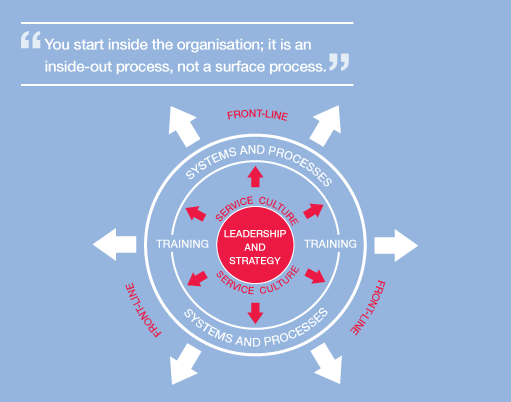
Nick Hague: Over half of the work we carry out is around customer experience and loyalty. If these are not bought into by the leadership, then it is just a box-ticking exercise. How do you bring everything together in terms of what we have been discussing today?
Chris Daffy: There needs to be someone in an organisation, preferably a leader or at least someone with influence, who really has conviction. They need to really believe that if we focus properly on looking after our customers, all of the other bits and pieces will fall into place. You see this in the Dorchester Group. Chris Cowdray is chief exec worldwide of the Dorchester Hotel Group, and he says “Listen folks, if we look after our guests in a way that they just don’t get at any other hotel in the world, they’ll keep coming back.” – and they do.
Travel Counsellors, came from nowhere to become the number one travel provider in just 10 to 15 years. When you meet David Speakman of Travel Counsellors, you meet a guy who says “We just give a service that nobody else does. We don’t sell travel, we sell relationships and trust and there just happens to be travel on the back of it.”
What you don’t want is someone who says “Can we do a cost justification on this?”. My soul goes “Goodness me. This person just doesn’t get it.” I remember Tom Peters once screaming from a conference stage “If you have to cost justify delivering exceptional service to your customers, you shouldn’t be in that job.”
So number one is conviction. Secondly there must be momentum. Momentum is mass times speed. You have to do it big, and you have to do it fast. You can’t play around at it; you can’t just have a couple of people who are trying to do it in this big organisation. You create a mass of people who fully understand what needs to be done and then you become very impatient: “Let’s get it done.” Without mass and speed, it flitters away. If it’s too slow, or there’s not enough of it being done, then your employees don’t think it’s very important anyway. Your customers don’t notice it because it is too gradual, and your competitors can keep up so there is nothing gained and there is no differentiation. For it to become a real differentiator, there must be momentum, which means that you go fast and you go big.
Nick Hague: Do you ever have to win in the support of people by showing examples of how it can work somewhere in their organisation. I can think of two or three examples where, in a huge multinational, there has been one country or one brand that has done great customer experience and shown how it can make a difference. Then everyone says “I want a piece of that.” and it gets rolled out to the wider organisation.
Chris Daffy: I call that a wildfire approach. You get some fires blazing somewhere that people can’t ignore, and then you say “This is what they’re doing; why don’t you try it?” I agree completely. In a big organisation, that is often the best way. You end up doing it much quicker than trying to do everybody else as well because you’ve got buy-in. One of my colleagues uses the phrase an awful lot: “People protect what they build.” If you build it for them, don’t expect them to want to protect it. If they choose it, and then build it themselves, they will protect it. The quicker you can get buy-in, and people saying “I would like that” rather than you saying “You’re going to have this”, I agree that you will get a much longer lasting and more impactful system or approach.
Nick Hague: Is there anywhere that you can point people to learn more about customer loyalty?
Chris Daffy: Well I would be failing myself if I didn’t mention my book called ‘Once a Customer, Always a Customer’. There is also my website, http://www.chrisdaffy.com/.
I also do training programs. There is a two or three day for senior management course to help with their understanding the subject. For people who are going to be the company’s internal implementers I run a 12 day program spread over three months.
Nick Hague: Chris, thank you so much for this conversation. I am sure we have all learned loads about how to “go beyond” in customer experience. It is the sort of subject where you never stop learning. So thanks for those final pointers as to where we can find out more.
Read more about customer satisfaction, loyalty and experience:
A Practical Guide to Improving Customer Satisfaction Loyalty – How To Win Devotion From Your Customers Beyond Customer Satisfaction


